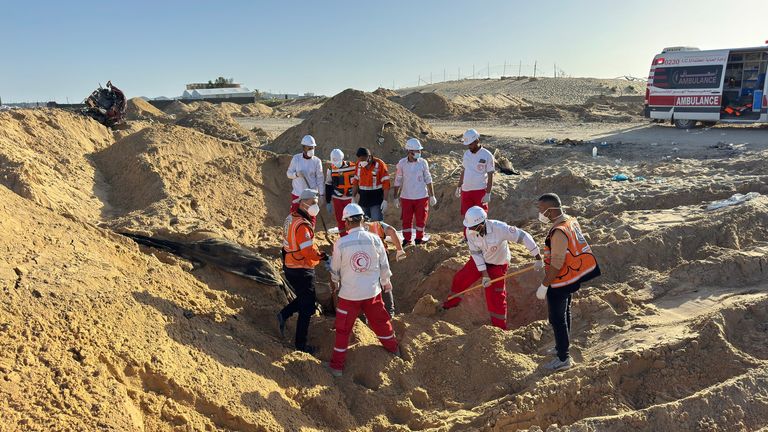Listeners:
Top listeners:
-
 play_arrow
play_arrow
RiseupRadio RiseupRadio UK
IDF report into deadly attack on aid workers is ‘full of lies’, Palestinian Red Crescent Society says

The Israeli military has said its investigation into the killing of aid workers in Gaza has found there were “several professional failures, breaches of orders, and a failure to fully report the incident”.
A deputy commander will be dismissed for providing an “inaccurate report” and a commanding officer will be reprimanded following the military probe, the Israel Defence Forces (IDF) said, adding there was “no attempt to conceal the event”.
Fifteen aid workers were shot dead by Israeli troops who opened fire on a convoy of vehicles, including ambulances, on 23 March.
They were then buried in a shallow grave where their bodies were found a week later by officials from the United Nations and the Palestinian Red Crescent.
Please use Chrome browser for a more accessible video player
 2:13
2:13
The probe’s findings come after a Sky News investigation earlier this week revealed how the deadly attack unfolded, contradicting Israel’s official account of the killings.
At first, Israel claimed the medics’ vehicles did not have emergency signals on when troops fired their shots, but later backtracked.
Mobile phone video which was recovered from one of the medics contradicted Israel’s initial account.
Footage showed the moment the aid workers were killed, with ambulances and fire insignia clearly visible and red lights flashing as they pulled up to help another ambulance that came under fire earlier.
Please use Chrome browser for a more accessible video player
 4:10
4:10
In a statement on Sunday, an IDF spokesperson said: “The Commanding Officer of the 14th Brigade will receive a reprimand, which will be recorded in his personal file, for his overall responsibility for the incident, including the procedure of combat and management of the scene afterward.
“The deputy commander of the Golani Reconnaissance Battalion will be dismissed from his position due to his responsibilities as the field commander in this incident and for providing an incomplete and inaccurate report during the debrief.”
The deputy commander is a “highly respected officer” who had returned from abroad to serve in reserve duty following Hamas’s 7 October attack, the IDF statement said.
The statement did not say if anyone would face criminal charges.
Nebal Farsakh, a spokesperson for the Red Crescent, told the AFP news agency that the report was “invalid” as it “shifts responsibility to a personal error in the field command when the truth is quite different”.
Please use Chrome browser for a more accessible video player
 1:28
1:28
‘Poor night visibility’
The Israeli military investigation found that the incident happened in a “hostile and dangerous combat zone” and the deputy commander did not initially recognise the vehicles as ambulances “due to poor night visibility”, according to the IDF spokesperson.
“Only later, after approaching the vehicles and scanning them, was it discovered that these were indeed rescue teams,” the spokesperson added.

The vehicles were clearly marked in the video with humanitarian symbols and the aid workers were wearing uniforms
The investigation said the Palestinians were killed because of an “operational misunderstanding” by Israeli forces, and that a separate incident 15 minutes later, when Israeli soldiers shot at a Palestinian UN vehicle, was a breach of orders.
IDF’s explanation about soldiers’ state of mind was striking
News correspondent
What was striking about the briefing by the Israeli military into their investigation of the killing of the Gaza medics, was the Israeli Defence Forces’ detailed explanation about the “state of the mind” of the Golani Reconnaissance Battalion.
It said the troops were in an “active combat zone” and had a “feeling” Hamas was operating around them.
The IDF blamed the attack on a series of operational mistakes.
First, in the early hours of the morning, the Israeli military attacked a vehicle they believed belonged to Hamas. Two Palestinians were killed. The Israeli military says a third man, Assad al Nsasrah, was questioned in basic Arabic, but the soldiers misunderstood him and thought he was admitting to being a member of the group.
The vehicle was, in fact, an ambulance and the men killed were medics. The military later realised this mistake. Al Nsasrah has been detained by Israel. Officials at the briefing offered no update on his situation.
The next incident was the convoy. The IDF said the deputy commander of the battalion opened fire because he failed to see that they were emergency vehicles.
The military said that from the position he was in and wearing his night vision goggles, the deputy commander could see the lights of the truck but not its siren and failed to identify it as a fire truck. He opened fire and the rest of the troops followed.
The IDF claimed it “made sense” that the battalion thought it was attacking Hamas.
It also said they started shooting because the men in the vehicles “stopped and got out”.
The IDF said six of the men were members of Hamas. But it provided no evidence of this. It said Hamas members sometimes had “day jobs”, implying they could be both medical workers and operatives. Again, no evidence was provided.
Probe looked at ‘three shooting incidents’
The IDF said that about an hour before the attack on the convoy, Israeli troops fired at what they “identified as a Hamas vehicle” and the forces “remained on high alert for further potential threats”.
In the convoy incident, the IDF said the soldiers “opened fire on suspects emerging from a fire truck and ambulances very close to the area in which the troops were operating, after perceiving an immediate and tangible threat”.
“Supporting surveillance” had reported five vehicles approaching rapidly and stopping near the troops, with passengers quickly disembarking, according to the IDF.
It said the deputy battalion commander “assessed the vehicles as employed by Hamas forces, who arrived to assist the first vehicle’s passengers”, adding that: “Under this impression and sense of threat, he ordered to open fire.”
Please use Chrome browser for a more accessible video player
 0:48
0:48
Install the Sky News app for free
According to the IDF, six of the 15 killed were “identified in a retrospective examination as Hamas terrorists”.
But the Sky News investigation found no evidence to support this claim, and the Israeli military has not produced any new evidence.
The IDF also said there was a third incident about 15 minutes later where “the troops fired at a Palestinian UN vehicle due to operational errors in breach of regulations”.
“The troops’ commander initially reported the event, and additional details emerged later in the examination,” it added.

A search team retrieves bodies from the mass grave on 30 March. Pic: UN
Bodies were buried in mass grave
Eight Red Crescent personnel, six civil defence workers and a UN staff member were killed in the shooting on the convoy by troops carrying out operations in Tel al Sultan, a district of the southern Gaza city of Rafah.
Troops then bulldozed over the bodies along with their mangled vehicles, burying them in a mass grave.
‘Decision to crush vehicles was wrong’
The IDF statement said that at dawn it was decided to “gather and cover the bodies to prevent further harm and clear the vehicles from the route in preparation for civilian evacuation”.
The body removal and vehicle crushing were carried out by field commanders, according to the military.
Removing the bodies was reasonable under the circumstances, but the decision to crush the vehicles was wrong, the investigation concluded, and “in general there was no attempt to conceal the event”.
“The examination found no evidence to support claims of execution or that any of the deceased were bound before or after the shooting,” the investigation added.

Follow our channel and never miss an update.
The probe also found that “the [gun]fire in the first two incidents resulted from an operational misunderstanding by the troops, who believed they faced a tangible threat from enemy forces”.
It added that the third incident “involved a breach of orders during a combat setting”.
The statement also said Israel’s military “regrets the harm caused to uninvolved civilians”.
Written by: admin
Similar posts
Recent Posts
- Israeli troops shot at Gaza aid workers from ‘point-blank range’, leaked documents reportedly show
- Nominees for Ivor Novello Awards revealed
- Chancellor outlines red lines for US trade deal
- Shawbrook weighs alternative to float with £5bn Starling merger approach
- Bin strike deal ‘could be in touching distance’
Recent Comments
-

Drive Time Show
Sing your heart out to our sing-along drive time music!
Turn it up, wind it down, and drive into the evening with good vibes only – only on Riseup Radio.
close Top popular
CONTACTS
- https://riseupradio.uk/
- +01 0101 01 23 31
- studio@riseupradio.uk
ABOUT
RiseupRadio is your feel-good online station, broadcasting from Greece and the UK. From throwbacks to party vibes, we’ve got the tunes to lift your day. Tune in and rise up with us!
© 2025 RiseupRadio. All rights reserved.
RiseupRadio.uk |
RiseupRadio.co.uk | RiseupRadio! App
All content is owned by RiseupRadio and may not be copied or reused without permission.











Post comments (0)